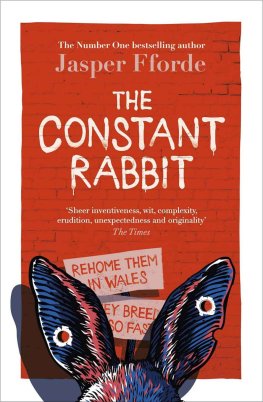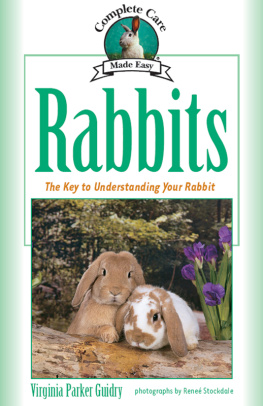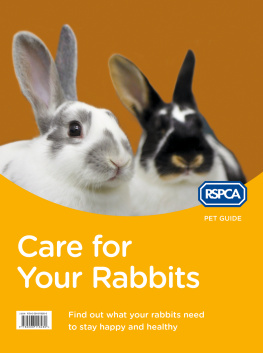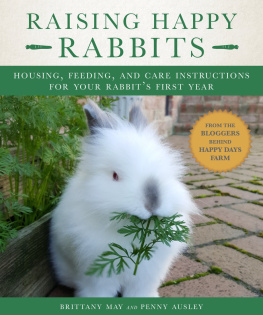ACKNOWLEDGEMENTS
To Sarah Heath for suggesting I write this book. To Jim McBride, Rachel Casey, Christina Huggett, John Stokes, Paul Beech, Sue White and Julia Tubb for all their helpful comments on the early drafts of this book. To Richard Desborough for his help with proof-reading and indexing. To Henry Plotkin at University College London for letting me study rabbit behaviour under his guidance all those years ago. To Nico Preston for all his support during years of rabbit watching. To Susan Hunter, Emma Magnus and Sally Machell and many unnamed rabbit owners for their provision of innumerable anecdotes and questions about rabbit behaviour. To my mother, Olga, for all her help and food parcels. To my brother, Deuce, and my friends, especially Shelagh, for their support, and to Nina Bonda-renko for giving the reader something to look at besides my prose. To my editor, Tessa Harrow, for being incredibly patient in understanding mat life sometimes gets in the way of doing pleasurable things like writing books about rabbits. To all of these I say thank you. Last but not least, my thanks to Thumper, Bunny, Nomad, Pixie, Andy, Circles and all their rabbity friends and relations for letting me share part of their lives.
Appendix One
PLANTS YOUR RABBIT SHOULD NOT EAT
Most good garden centres and nurseries will label plants which are toxic or cause skin allergies. If in doubt, do please contact your veterinary surgeon for advice.
The following list is adapted from the Petplan publication Top to Tail, edited by John and Caroline Bower. Where possible I have given the common as well as the Latin name.
CATEGORY A
These plants are poisonous if eaten and will commonly cause severe blistering if they come into contact with skin.
Rhus succedanea | Rhus are part of the Sumach family, poison sumach |
Rhus tyhina |
Rhus verniciflua |
CATEGORY B
These plants are toxic if eaten and may cause a skin allergy.
Aconitum | Monkshood |
Atropa belladonna | Deadly nightshade |
Colchicum | Autumn crocus, meadow saffron, naked ladies |
Convallaria majalis | Lily-of-the-valley |
Daphne laureola | Spurge laurel |
Daphne mezereum | Mesereon, the popular |
deciduous daphne |
Other laurel species |
Dictamnus albus | Dittany, burning bush |
Dieffenbachia | Dumb cane, leopard lily |
Digitalis | Foxglove |
Gaultheria | Small shrubs with white, |
pink, purple or blue |
berries, also known as |
pernettyas |
Gloriosa superba | Glory lily |
Hyoscyamus niger | Henbane |
Laburnum | Laburnum, golden rain |
Lantana |
Nerium oleander | Oleander, rose bay |
Phytolacca | Pokeroot, pokeweed |
Primula obconica | German primula, poison |
primula |
Ricinus communis | Castor oil plant |
Ruta | Rue |
Solanum dulcamara | Bittersweet, woody |
nightshade |
Taxus | Yew |
Veratrum album | False hellebore |
Zantedeschia aethiopica | Arum lily |
CATEGORY C
These plants are harmful if eaten and can cause skin allergy.
Aesculus | Horse chestnut |
Agrostemma | Corn cockle |
Alstroemeria | Peruvian lily |
Aquilegia | Columbine |
Brugmansia | Angels trumpets |
Caltha | Kingcup, marsh marigold |
Caltharanthus roseus |
Cupressocyparis leylandii | Leyland cypress (often |
used as hedging) |
Delphinium | Delphinium |
Dendrathema | Formerly classified as |
chrysanthemums |
Echium | Vipers bugloss |
Euonymus | Spindle tree |
Euphorbia | Spurge |
| Ficus carica | Fig (both for indoor and |
outdoor growing) |
Fremontodendron | Flannel bush |
Hedera | Ivy |
Helleborus | All Helleborus |
Hyacinthoides | Bluebell |
Hyacinthus | Hyacinth |
Hypericum | St Johns Wort |
Ipomoea | Morning glory |
Iris | Iris |
Juniperus sabina | Juniper |
Kalmia latifolia | Calico bush, mountain |
laurel |
Ligustrum | Privet |
Lobelia spp. | Lobelia |
Lupinus | Lupins |
Narcissus | Narcissus, daffodils |
Ornithogalum | Star-of-Bethlehem |
Polygonatum | Solomons seal |
Prunus laurocerasus | Cherry laurel |
Rhamnus | Buckthorn |
Schefflera | Ivy tree |
Thuja | (hedging conifers) |
Tulipa | Tulips |
Wisteria | Wisteria |
If you are in doubt, please do not give a plant, flower or twig to your rabbit. If you think your rabbit has eaten anything poisonous, do not delay but take it straight to your veterinary surgeon.
Appendix Two
HOW TO TEACH YOUR DOG TO LEAVE
Leave means Leave it, it is boring. Pay attention to me; I am exciting and rewarding. As a consequence, Leave is a gently spoken command and the dog is rewarded verbally as well as with food or play.
Remember that the more important what you are asking the dog to leave is to the dog, the greater the payment you will have to offer. Would you leave your pen for someone who said Please and offered you 2.00? Would you leave your car for the same price? I suspect not, but you might for 20,000.
Stage A
Hold a piece of food in the tips of your fingers. As the dog approaches, say Leave gently and close your hand.
As the dog retracts its head, say Good. Leave. Take it, and give the dog the food.
When the dog is clear that it has to move its head away from the food in order to obtain it, then move on to the next stage.
Stage B
Sit in a chair. Hold your right arm, with the food in your fingers, out to the right. As the dog goes to take the food, say Leave. If the dog does not move its head away, close your fingers and repeat the command. When it does move its head away, bring the food back to your lap (crotch), and tell the dog to Take it and give it the food ... making it come to your lap for the food.






